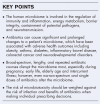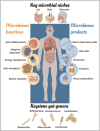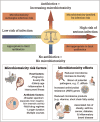Microbiotoxicity: antibiotic usage and its unintended harm to the microbiome
- PMID: 37466039
- PMCID: PMC10487351
- DOI: 10.1097/QCO.0000000000000945
Microbiotoxicity: antibiotic usage and its unintended harm to the microbiome
Abstract
Purpose of review: Antibiotic use is associated with development of antimicrobial resistance and dysregulation of the microbiome (the overall host microbial community). These changes have in turn been associated with downstream adverse health outcomes. This review analyses recent important publications in a rapidly evolving field, contextualizing the available evidence to assist clinicians weighing the potential risks of antibiotics on a patient's microbiome.
Recent finding: Although the majority of microbiome research is observational, we highlight recent interventional studies probing the associations between antibiotic use, microbiome disruption, and ill-health. These studies include germ-free mouse models, antibiotic challenge in healthy human volunteers, and a phase III study of the world's first approved microbiome-based medicine.
Summary: The growing body of relevant clinical and experimental evidence for antibiotic-mediated microbiome perturbation is concerning, although further causal evidence is required. Within the limits of this evidence, we propose the novel term 'microbiotoxicity' to describe the unintended harms of antibiotics on a patient's microbiome. We suggest a framework for prescribers to weigh microbiotoxic effects against the intended benefits of antibiotic use.
Copyright © 2023 The Author(s). Published by Wolters Kluwer Health, Inc.
Conflict of interest statement
Figures




Similar articles
-
Interventions to improve antibiotic prescribing practices for hospital inpatients.Cochrane Database Syst Rev. 2013 Apr 30;(4):CD003543. doi: 10.1002/14651858.CD003543.pub3. Cochrane Database Syst Rev. 2013. Update in: Cochrane Database Syst Rev. 2017 Feb 09;2:CD003543. doi: 10.1002/14651858.CD003543.pub4. PMID: 23633313 Updated.
-
Interventions to improve antibiotic prescribing practices for hospital inpatients.Cochrane Database Syst Rev. 2017 Feb 9;2(2):CD003543. doi: 10.1002/14651858.CD003543.pub4. Cochrane Database Syst Rev. 2017. PMID: 28178770 Free PMC article.
-
Biomarkers as point-of-care tests to guide prescription of antibiotics in people with acute respiratory infections in primary care.Cochrane Database Syst Rev. 2022 Oct 17;10(10):CD010130. doi: 10.1002/14651858.CD010130.pub3. Cochrane Database Syst Rev. 2022. PMID: 36250577 Free PMC article.
-
Immediate versus delayed versus no antibiotics for respiratory infections.Cochrane Database Syst Rev. 2023 Oct 4;10(10):CD004417. doi: 10.1002/14651858.CD004417.pub6. Cochrane Database Syst Rev. 2023. PMID: 37791590 Free PMC article.
-
Biomarkers as point-of-care tests to guide prescription of antibiotics in patients with acute respiratory infections in primary care.Cochrane Database Syst Rev. 2014 Nov 6;(11):CD010130. doi: 10.1002/14651858.CD010130.pub2. Cochrane Database Syst Rev. 2014. Update in: Cochrane Database Syst Rev. 2022 Oct 17;10:CD010130. doi: 10.1002/14651858.CD010130.pub3. PMID: 25374293 Updated.
Cited by
-
Analysis of ESAC-Net/EARS-Net Data from 29 EEA Countries for Spatiotemporal Associations Between Antimicrobial Use and Resistance-Implications for Antimicrobial Stewardship?Antibiotics (Basel). 2025 Apr 13;14(4):399. doi: 10.3390/antibiotics14040399. Antibiotics (Basel). 2025. PMID: 40298555 Free PMC article.
-
Natural Antimicrobial Agents from Algae: Current Advances and Future Directions.Int J Mol Sci. 2024 Nov 4;25(21):11826. doi: 10.3390/ijms252111826. Int J Mol Sci. 2024. PMID: 39519377 Free PMC article. Review.
-
Performance of BIOFIRE FILMARRAY pneumonia panel in suspected pneumonia: insights from a real-world study.Microbiol Spectr. 2025 Jul;13(7):e0057125. doi: 10.1128/spectrum.00571-25. Epub 2025 May 22. Microbiol Spectr. 2025. PMID: 40401975 Free PMC article.
-
Current Approaches to Prevent or Reverse Microbiome Dysbiosis in Chronic Inflammatory Rheumatic Diseases.Mediterr J Rheumatol. 2024 Jun 30;35(2):220-233. doi: 10.31138/mjr.240224.cap. eCollection 2024 Jun. Mediterr J Rheumatol. 2024. PMID: 39211023 Free PMC article. Review.
References
-
- Antimicrobial Resistance Collaborators. Global burden of bacterial antimicrobial resistance in 2019: a systematic analysis. Lancet 2022; 399:629–655. - PMC - PubMed
-
First comprehensive assessment of global burden of antimicrobial resistance (AMR), including deaths and disability-adjusted life-years.
-
- Cox JAG, Worthington T. The ‘antibiotic apocalypse’ - scaremongering or scientific reporting? Trends Microbiol 2017; 25:167–169. - PubMed
-
- Collignon P, Beggs JJ, Walsh TR, et al. . Anthropological and socioeconomic factors contributing to global antimicrobial resistance: a univariate and multivariable analysis. Lancet Planet Health 2018; 2:e398–e405. - PubMed
Publication types
MeSH terms
Substances
Grants and funding
LinkOut - more resources
Full Text Sources
Medical
Research Materials

